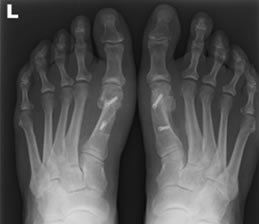in Foot and Ankle Surgery and Reconstruction
Over 150 different operations to correct a bunion have been described. The operation your surgeon will choose will be the right one for you. Every case is different and but your surgeon should rationalise his choice with you so you fully understand. Commonly performed are the “Scarf osteotomy” or the “Chevron osteotomy” both of which have significant evidence in the world medical literature to support their use.
It is a day-case procedure. The operation is done under a general anaesthesia and an added injection in the foot to numb it for after surgery. The operation will involve generally 2 incisions around your big toe. The procedure involves carefully removing the prominent bump on the side of the foot and incising ligaments and tendons around your toe joints to re-align your toe. The metatarsal bone is then cut (osteotomy) to reposition the bones and effectively narrow your foot. The osteotomy is then held in place with small metal screws that stay in. Dissolvable skin stitches are used.

Your foot will be bandaged, numb and pain free. You will see a physiotherapist who will advise on walking in a padded stiff shoe supplied. You will have an X-Ray before discharge. You will be discharged only when comfortable and given a follow-up appointment and pain-killers as required.
In the first 2 weeks keep the bandaging totally dry. You may shower with a waterproof cover over the plaster. After 2 weeks you can only shower if the wound is healed but gently dab the wound dry then re-apply toe splint.
Once out of bandaging, do not pull at scabs but let them fall away naturally. If your wound becomes red, swollen or sore you need to see your Consultant to ensure there is no infection present. Your physiotherapist may advise on wound massage once it is healed.
Your physiotherapist will guide you through the stages of rehabilitation including gait re-education, toe mobilisation exercises, swelling reduction and reducing muscle tightness. It is important to adhere to advice given.
DVLA states it is the responsibility of the driver to ensure they are always in control of the vehicle. A good guide is if you can stamp down hard with the foot to stop the car in an emergency stop. This will take at least 6 weeks. Click here to read DVLA guidance.
This is very individual and job-dependent. Below is a guide:
Excellent pain relief once the toe has healed, which can take 6 weeks. Good level of activity by 3 months. Fully recovered by 6-12 months with full sports and activity. It is a very successful operation with 90% patients satisfied. Mild swelling can persist in the foot for up to a year.
Any operation carries a risk. Below is a guide to some risks potentially encountered. It is the surgeons duty to fully inform you of possible risks. Mr Roche will ensure this is always done so patients can make safe and informed choices about their operation.
If this happens, it is usually simply treated with antibiotics. Significant consequences from infection are very rare but can be dealt with. Risk is around 1%.
Small nerves that supply sensation to the skin are near the incision site. Damage is rare but if your toe stays numb after surgery, the nerve may be bruised. If so it usually recovers. Risk is around 5%.
Usually more of an issue in severe cases, it does not often cause recurrence of symptoms, but a mild cosmetic deformity can persist. Further surgery can be discussed as needed. Risk is around 5%.
The toe can be straightened too much so that it actually deforms away from the original direction towards the other foot (Hallux Varus). This is a very rare complication and usually requires further surgery. Risk is around 1%.
Symptomatic clot formation in the leg is unusual after foot and ankle surgery (<3%). Whether treatment to prevent clot is needed can be discussed with your surgeon. There is no consensus amongst UK Orthopaedic surgeons as to whether preventative medicine is needed.
This document is only meant to be a guideline to help you understand your treatment and what to expect. Every person is different and your rehabilitation may be quicker and slower. This will be advised and guided by your doctor and physiotherapist.